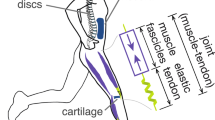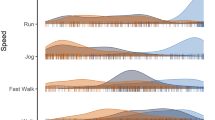Abstract
The muscular work of galloping in horses is halved by storing and returning elastic strain energy in spring-like muscle–tendon units1,2.These make the legs act like a child's pogo stick that is tuned to stretch and recoil at 2.5 strides per second. This mechanism is optimized by unique musculoskeletal adaptations: the digital flexor muscles have extremely short fibres and significant passive properties, whereas the tendons are very long and span several joints3,4. Length change occurs by a stretching of the spring-like digital flexor tendons rather than through energetically expensive length changes in the muscle5. Despite being apparently redundant for such a mechanism5, the muscle fibres in the digital flexors are well developed. Here we show that the mechanical arrangement of the elastic leg permits it to vibrate at a higher frequency of 30–40 Hz that could cause fatigue damage to tendon and bone. Furthermore, we show that the digital flexor muscles have minimal ability to contribute to or regulate significantly the 2.5-Hz cycle of movement, but are ideally arranged to damp these high-frequency oscillations in the limb.
This is a preview of subscription content, access via your institution
Access options
Subscribe to this journal
Receive 51 print issues and online access
$199.00 per year
only $3.90 per issue
Buy this article
- Purchase on Springer Link
- Instant access to full article PDF
Prices may be subject to local taxes which are calculated during checkout





Similar content being viewed by others
References
Dimery, N. J., Alexander, R. McN. & Ker, R. F. Elastic extension of leg tendons in the locomotion of horses (Equus caballus). J. Zool. 210, 415–425 (1986).
Minetti, A. E., Ardigo, L. P., Reinach, E. & Saibene, F. The relationship between mechanical work and energy expenditure of locomotion in horses. J. Exp. Biol. 202, 2329–2338 (1999).
Alexander, R. McN. & Bennet-Clark, H. C. Storage of elastic strain energy in muscle and other tissues. Nature 265, 114–117 (1977).
Alexander, R. McN. Elastic Mechanisms in Animal Movement (Cambridge Univ. Press, Cambridge, 1988).
Biewener, A. A. & Roberts, T. J. Muscle and tendon contributions to force, work and elastic energy savings: a comparative perspective. Exercise Sport Sci. Rev. 28, 99–107 (2000).
Biewener, A. A. Muscle–tendon stresses and elastic energy storage during locomotion in the horse. Comp. Biochem. Physiol. B 120, 73–87 (1998).
Biewener, A. A., Konieczynski, D. D. & Baudinette, R. V. In vivo muscle force-length behaviour during steady state hopping in tammar wallabies. J. Exp. Biol. 201, 1681–1694 (1998).
Hof, A. L. In vivo measurement of the series elasticity release curve of human triceps surae muscle. J. Biomech. 31, 793–800 (1998).
Kurokawa, S., Fukunaga, T. & Fukashiro, S. Behaviour of fascicles and tendinous structures of human gastrocnemius during vertical jumping. J. Appl. Physiol 90, 1349–1358 (2001).
Grandage, J. Penniform muscles of the horses forelimb. J. Anat. Abstr. 132, 318 (1981).
Hermanson, J. W. & Cobb, M. A. Four forearm flexor muscles of the horse, Equus caballus: anatomy and histochemistry. J. Morphol. 212, 269–280 (1992).
Stephens, P. R., Nunamaker, D. M. & Butterweck, D. M. Application of a Hall effect transducer for the measurement of tendon strains in horses. Am. J. Vet. Res. 50, 1089–1095 (1989).
Herrick, W. C., Kingsbury, H. B. & Lou, D. Y. S. A study of the normal range of strain, strain rate and stiffness of tendon. J. Biomed. Mat. Res. 12, 877–894 (1978).
Bogert, A. J., van den Gerritsen, K. G. M. & Cole, G. K. Human muscle modeling from a user's perspective. J. Electromyog. Kinesiol. 8, 119–124 (1998).
van Weeren, P. R., van den Bogert, A. J., Back, W., Bruin, G. & Barneveld, A. Kinematics of the standardbred trotter measured at 6, 7, 8 and 9 ms-1 on a treadmill after 5 months of prerace training. Acta Anat. 146, 154–161 (1993).
van den Bogert, A. J. & Schamhardt, H. C. Multi-body modelling and simulation of animal locomotion. Acta Anat. 146, 95–102 (1993).
Lake, M. J., Coyles, V. R. & Lees, A. High frequency characteristics of the lower limb during running. Proc. 18th Congr. Int. Soc. Biomech. (eds Müller, R., Gerber, H. & Stacoff, A.) 200–201 (Laboratory for Biomechanics, ETH Zurich, 2001).
Carter, D. R. Mechanical loading histories and cortical bone remodeling. Calcif. Tissue Int. 36(Suppl.), 19–24 (1984).
Wang, X. T., Ker, R. F. & Alexander, R. McN. Fatigue rupture of wallaby tail tendons. J. Exp. Biol. 198, 847–852 (1995).
Cheney, J. A., Liou, S. Y. & Wheat, J. D. Cannon bone fracture in the thoroughbred racehorse. Med. Bio. Eng. 11, 613–620 (1973).
Nunamaker, D. M., Butterweck, D. M. & Provost, M. T. Fatigue fractures in thoroughbred racehorses: relationships with age, peak bone strain, and training. J. Orthop. Res. 8, 604–611 (1990).
Dow, S. M., Leendertz, J. A., Silver, I. A. & Goodship, A. E. Identification of subclinical tendon injury from ground reaction force analysis. Equine Vet. J. 23, 266–272 (1991).
Pratt, G. A. et al. Stiffness isn’t everything. Proc. 4th Int. Symp. Experimental Robotics, ISER, Stanford, California 173–178 (1995).
Ettema, G. J. C. & Huijing, P. A. Frequency response of rat gastrocnemius medialis in small amplitude vibrations. J. Biomech. 27, 1015–1022 (1994).
Kawai, M. & Brandt, P. W. Sinusoidal analysis: A high resolution method for correlating biochemical reactions with physiological processes in the activated skeletal muscles of rabbit, frog and crayfish. J. Muscle Res. Cell. Motil. 1, 279–303 (1980).
Piazzesi, G. & Lombardi, V. A cross-bridge model that is able to explain mechanical and energetic properties of shortening muscle. Biophys J. 68, 1966–1979 (1995).
Piazzesi, G. & Lombardi, V. Simulation of the rapid regeneration of the actin–myosin working stroke with a tight coupling model of muscle contraction. J. Muscle Res. Cell. Motil. 17, 45–53 (1996).
van den Bogert, A. J. Computer Simulation of Locomotion in the Horse. Thesis, Univ. Utrecht, The Netherlands (1989).
van Soest, A. J. & Bobbert, M. F. The contribution of muscle properties in the control of explosive movements. Biol. Cybern. 69, 195–204 (1993).
Gerritsen, K. G. M., van den Bogert, A. J. & Nigg, B. M. Direct dynamics simulation of the impact phase in heel–toe running. J. Biomech. 28, 661–668 (1995).
Acknowledgements
We acknowledge the assistance of R. C. Woledge in carrying out the cross-bridge model calculations and thank him for comments on the manuscript. We thank the Horserace Betting Levy Board, London, for funding this work.
Author information
Authors and Affiliations
Corresponding author
Ethics declarations
Competing interests
The authors declare no competing financial interests.
Rights and permissions
About this article
Cite this article
Wilson, A., McGuigan, M., Su, A. et al. Horses damp the spring in their step. Nature 414, 895–899 (2001). https://doi.org/10.1038/414895a
Received:
Accepted:
Issue Date:
DOI: https://doi.org/10.1038/414895a
This article is cited by
-
Slack-based tunable damping leads to a trade-off between robustness and efficiency in legged locomotion
Scientific Reports (2023)
-
Biological Vibration Damping Strategies and Mechanisms
Journal of Bionic Engineering (2023)
-
Design and experiment of bio-inspired GER fluid damper
Science China Information Sciences (2020)
-
Biomechanics of predator–prey arms race in lion, zebra, cheetah and impala
Nature (2018)
-
Strain in shock-loaded skeletal muscle and the time scale of muscular wobbling mass dynamics
Scientific Reports (2017)
Comments
By submitting a comment you agree to abide by our Terms and Community Guidelines. If you find something abusive or that does not comply with our terms or guidelines please flag it as inappropriate.



